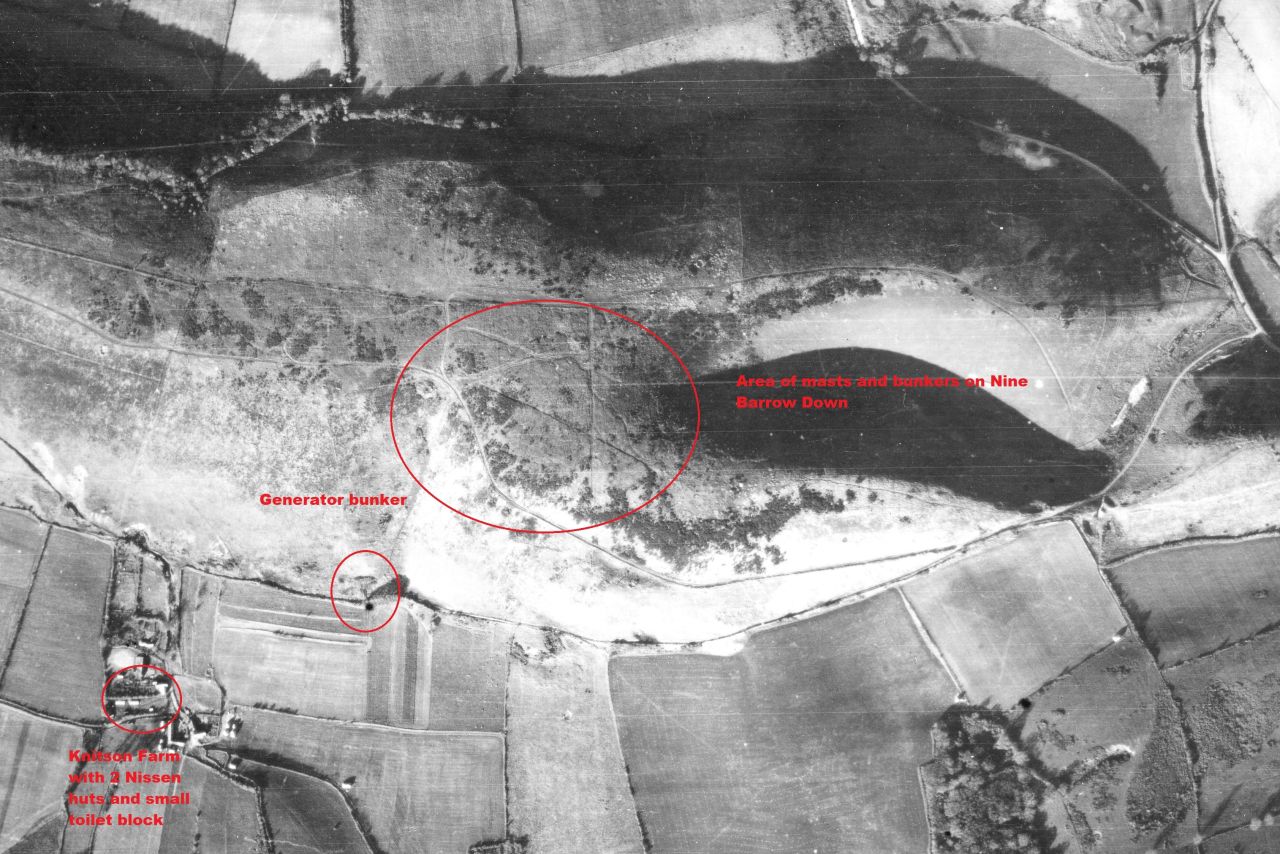While Patrols from elsewhere in the country were sent to the Isle of Wight around D Day to provide guard patrols there, in Dorset there were plenty of important points that needed defending. Auxiliers were drawn from across the county to form into patrols based on the men available.
Knitson Farm
This was the location of a large communications facility which had been constructed starting in 1936. Masts were erected on Nine Barrow Down and and underground control facility built from three double Nissen huts buried under concrete and grassed over. At the bottom of the hill was a large generator bunker formed from an oversized Nissen type hut with a pair of roof hatches accessed via shafts at either end. The side entrance had a brick and concrete lobby with a couple of rooms and then steps leading down to a track towards the farm. The steps had a built in ramp either side to allow the generator trailers to be hoisted up to the main bunker. This is on private property and not accessible due to its dangerous condition. The steps can be seen from a footpath along the track.
The exact purpose of this site still remains a mystery. It was nominally under Royal Navy control, but civilians, Army and RAF personnel all worked there. In the run up to D Day US Navy personnel were also seen. This was not a part of the Telecommunications Research Establishment (TRE) formerly located at nearby Leeson House and Worth Matravers, nor part of the Y intercept service.
Accommodation for the personnel included a pair of Nissen huts and a small toilet block at Knitson Farm. After the war, one Nissen hut became part of a neighbouring property but still survives. The farm continued to operate amongst the military activity. Mr STJ Smith was the tenant farmer, though he sold up in 1945, disposing of his Fordson tractor, 2 working horses and a 52 strong dairy herd. He had taken over from F and H Curtis, who had sold up in 1937 through FW Cottee, auctioneer and estate agent. He had three children and during the war advertised both for a housekeeper, as well as an additional farmhand.
The Auxiliary Units men who were brought in were used to provide guard patrols at night. It seems the younger men were selected by preference. They were provided with tents in a field to sleep during the day. They slept 8 men to each tent. The RAF Regiment provided the daytime patrols. The fear was that a German raid might knock out the vital communications needed to control the huge invasion forces. The Auxiliers however knew nothing about what was going on. Some only knew they were guarding a door in the hillside!
Sergeant Fred Simpson from the Creech patrol kept a diary of his period of duty, even though this was officially forbidden.
| Name | Occupation | Posted from | Until |
|---|---|---|---|
| Second Lieutenant Albert Grimshaw Biggs Willshire | Torpedo Range Firing Staff, Whitehead Torpedo Company, Wyke Regis, Weymouth. |
03 Jul 1944 | 03 Jul 1944 |
| Captain Archibald Douglas Hubbard | Tea planter |
11 Jun 1944 | 11 Jun 1944 |
| Sergeant Edwin Thomas Fooks | Thatcher |
06 Jun 1944 | 13 Jun 1944 |
| Sergeant Frederick James Simpson | Farm worker |
05 Jun 1944 | 13 Jun 1944 |
| Private William Fred Dare | Father Dairy Farmer |
06 Jun 1944 | unknown |
| Private Lewis Henry Downton | Farm Carter ARP Messenger |
03 Jul 1944 | 03 Jul 1944 |
| Private Anthony Albert Holden | Father Railway Signalman |
06 Jun 1944 | 13 Jun 1944 |
| Private Percy Edwin Miller | Agricultural labourer |
06 Jun 1944 | 13 Jun 1944 |
| Private Gordon Cecil Outram | Master Carpenter |
06 Jun 1944 | 13 Jun 1944 |
| Private George Oakley Parker | Farm Labourer |
06 Jun 1944 | 13 Jun 1944 |
| Private Ronald Edward Vallis | Agricultural worker |
06 Jun 1944 | 13 Jun 1944 |
| Private Samuel Edgar Wrixon | Dairy Farmer |
06 Jun 1944 | 13 Jun 1944 |
D Day Dorset Guard Duties
The Evolution of a Purbeck Farm, Knitson in the parish of Langton Matravers, MC Helfer, 2004 Langton Matravers Local History and Preservation Society
Western Gazette, 4 Apr 1941, 6 Oct 1944, 31 Aug 1945, 21 Sep 1945
